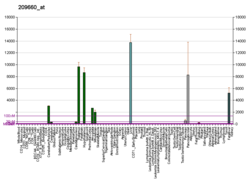Transthyretin (TTR or TBPA) is a transport protein in the plasma and cerebrospinal fluid that transports the thyroid hormone thyroxine (T4) and retinol to the liver. This is how transthyretin gained its name: transports thyroxine and retinol. The liver secretes TTR into the blood, and the choroid plexus secretes TTR into the cerebrospinal fluid.
TTR was originally called prealbumin [5] (or thyroxine-binding prealbumin) because it migrated faster than albumin on electrophoresis gels. Prealbumin was felt to be a misleading name, it is not a synthetic precursor of albumin. The alternative name TTR was proposed by DeWitt Goodman in 1981.
Human transthyretrin protein is encoded by the TTR gene, which is located on the long arm of chromosome 18, in cytogenetic band 18q12.1.















































































